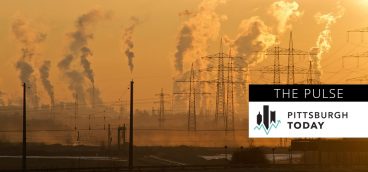Breathing Bad Air

Air pollution from traffic and industrial stacks finds its way to most places in Allegheny County. But minority and low-income neighborhoods are more likely to endure the highest levels and the health risks that come with not being able to find respite from bad air, a University of Pittsburgh study reports.
Researchers mapped black carbon and nitrogen dioxide levels and data on coronary heart disease using a model built by the Center of Healthy Environments and Communities at Pitt’s Graduate School of Public Health. What they found is that as the pollutants snake across the county, they leave a trail of communities that are more heavily impacted than others, but spare none.
The leafier, less populated remote suburbs avoid the highest doses of the air pollutants, each of which medical research links to elevated risk of heart and respiratory diseases and other serious health conditions.
But pollution hot spots claim dozens of neighborhoods closest to the most prolific sources of black carbon and nitrogen dioxide.
Hot spots
The model was developed with Carnegie Mellon researchers NS plots the intensity of the two pollutants across census tracts as they travel from their source. It also estimates health risks using data of coronary heart disease cases and deaths in those communities.
Characteristics of each pollutant influence how they spread. When mapped, their concentrations reveal the consequences of having heavy industry in thickly populated places and of decades of transportation policies focused on building high-density highways into and around urban centers to accommodate suburban expansion.
Heavy concentrations of black carbon, whose chief sources include diesel engines and industry, are often found near power and industrial plants. The maps show that the highest levels are attracted to communities nestled in river valleys, such as Clairton, Liberty, and McKeesport along the Monongahela River, several along the Allegheny from Blawnox east to the county line, and a few along the Ohio, from the City of Pittsburgh to Neville Island and westward.
NO2 levels are common measures of traffic-related air pollution that form from the emissions of cars, trucks, and coal-fired power plants and mills. The highest concentrations are seen along heavily traveled roads, such as the county’s parkways, in and around Downtown Pittsburgh, and in several river towns where industrial emissions are common.
Income, race and risk
The exposure of communities where a large share of residents can’t afford to escape to the suburbs drives the stark income and race disparities in health risk that are reported in the study.
Hardest hit are “environmental justice” communities, defined as places where at least 20 percent of residents live in poverty or 30 percent or more are non-white minorities, or both.
In Allegheny County, such communities are 20 times more likely to endure the highest concentrations of NO2 pollution than places with more white residents and households with higher incomes, the study reports.
And 40 percent of the estimated pollution-related coronary heart disease deaths were among residents of environmental justice communities, even though those neighborhoods account for only 27 percent of the county population.
Coronary heart disease isn’t the only elevated health concern residents of those neighborhoods face disproportionately. Black carbon and NO2 contribute to other air pollutants, such as fine particulates and ground-level ozone. And the list of health problems associated with them include asthma and other respiratory diseases, stroke, adverse birth outcomes and others.
“What is driving the disparities is the risk within a small geographic location. So, for any of the diseases associated with exposure to air pollution, the same disparities will still be there,” said James Fabisiak, director of the Center of Healthy Environments and Communities.
And during the COVID-19 pandemic, any of those diseases would be the kind of underlying condition that doctors say complicate the recovery of patients who contract the coronavirus.
Researchers estimate that coronary heart disease deaths alone could be reduced by 100 a year if exposure to black carbon and NO2 in environmental justice communities was brought down to the lowest levels recorded in the county, such as those in Marshall, Pine, Findlay, North Fayette and other far suburbs. “Rather than eliminate all air pollution in total, which is an unrealistic expectation, if we could just clean it up that much, that’s the benefit we could get,” Fabisiak said.





